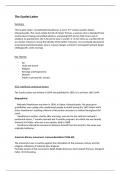The Scarlet Letter
Summary
‘The Scarlet Letter’, by Nathaniel Hawthorne, is set in 17 th century puritan Salem,
Massachusetts. The novel entails the life of Hester Prynne, a woman who is alienated from
society due to having committed adultery, and giving birth to her child, Pearl, out of
wedlock. As punishment, she is forced to wear a scarlet ‘A’ on her dress as a symbol of her
sin. Hester refuses to reveal the identity of the father; however, it is eventually discovered
to be Reverend Dimmesdale, who is in grave danger as Hester’s estranged husband, Roger
Chillingworth, seeks revenge.
Key Themes
- Sin
- Guilt and shame
- Religion
- Revenge and forgiveness
- Women
- Public vs private life, secrets
AO3- significant contextual factors
The Scarlet Letter was written in 1849 and published in 1850. It is set from 1642-1649.
Biographical:
Nathaniel Hawthorne was born in 1804, in Salem, Massachusetts. His great great
grandfather was a judge who condemned people to death during the 1692 Salem witch
trials; Hawthorne’s scathing criticism of his puritan ancestors is evident throughout the
novel.
Hawthorne’s mother, shortly after marrying, was sent to live with her husband’s
puritanical sisters, 7 months married and 9 months pregnant, for which she was heavily
shamed. His father, who was a sea captain, died in 1808.
Hawthorne altered his surname to distance himself from his ancestry: the name was
originally Hathorne.
American literary movement- transcendentalism (1836-60):
The movement was a reaction against the rationalism of the previous century and the
religious orthodoxy of Calvinist New England.
Principle writers of the movement: Ralph Waldo Emerson, Henry David Thoreau, Margaret
Fuller, W.H.Channing.




